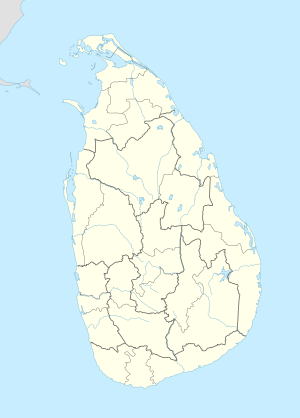Anuradhapura massacre
| Anuradhapura massacre | |
|---|---|
 Anuradhapura Anuradhapura (Sri Lanka) | |
| Location | Anuradhapura, Sri Lanka |
| Date | May 14, 1985 |
Attack type | Massacre |
| Weapons | Guns |
| Deaths | 146 Sinhalese men, women and children |
| Perpetrators | Liberation Tigers of Tamil Eelam (LTTE) |
The Anuradhapura massacre occurred in Sri Lanka in 1985 and was carried out by the Liberation Tigers of Tamil Eelam.[1][2] This was the largest massacre of Sinhalese civilians by the LTTE to date; it was also the first major operation carried out by the LTTE outside a Tamil majority area. Initially, EROS claimed responsibility for the massacre, but it later retracted the statement, and joined the PLOTE in denouncing the incident. The groups later accused the LTTE for the attack.[3] Since then, no Tamil militant group has admitted to committing the massacre.[4] However, state intelligence discovered that the operation was ordered by the LTTE Mannar commander Marcelin Fuselus (alias Victor) and executed by his subordinate Anthony Kaththiar (alias Radha).[5][6] The attack was allegedly sparked by the 1985 Valvettiturai massacre, where the Sri Lanka Army massacred 70 Tamil civilians in the LTTE's leader hometown.[7]
Incident[]
The LTTE hijacked a bus on May 14, 1985, and entered Anuradhapura. As the cadres entered the main bus station, they opened fire indiscriminately with automatic weapons killing and wounding many civilians who were waiting for buses.[8] The cadres then drove to the Sri Maha Bodhi shrine and gunned down nuns, monks and civilians as they were worshipping inside the Buddhist shrine.[9] Before they withdrew, the attacker's strike force entered the national park of Wilpattu and killed 18 Sinhalese in the forest reserve. The attackers had massacred 146 Sinhalese men, women and children in total, in Anuradhapura.[citation needed]
According to HRW,
“Initially, a small militant organization, the Eelam Revolutionary Organization of Students (EROS) claimed responsibility for the massacre, but it later retracted the statement, and joined the People's Liberation Organization for Tamil Eelam (PLOTE) in denouncing the incident. The groups accused the LTTE.”[10]
Retaliation[]
An angered army corporal opened fire on nine Tamil civilians who went to an army camp to seek refuge. He was killed by his commanding officer.[11] Several Tamil shops were attacked in Anuradhapura and Colombo. At least two Tamils bodies were on the street in the former city.[12] On the two days following the attack, 75 Tamil civilians were killed by the Sri Lankan Army in retaliation, including at the Kumudini boat massacre.[13]
References[]
- ^ Barry Rubin; Judith Colp Rubin (2015). Chronologies of Modern Terrorism. Routledge. p. 149. ISBN 9781317474654.
LTTE terrorist in Anuradhapura, Sri Lanka, massacre about 120 Sinhalese and injure 58 others, many of them pilgrims who were inside the sacred Bo Tree temple
- ^ Atalia Omer; Jason A. Springs (2013). Religious Nationalism: A Reference Handbook: A Reference Handbook: Contemporary World Issues. ABC-CLIO. ISBN 9781598844405.
LTTE commits the Anuradhapura massacre of civilians. This is one of the LTTE's largest massacres to date.
- ^ "GENERAL". www.hrw.org. Retrieved 2017-09-14.
- ^ Amarasingam, Amarnath (2015). Pain, Pride, and Politics: Social Movement Activism and the Sri Lankan Tamil Diaspora in Canada. University of Georgia Press. p. 38. ISBN 9780820348148.
Although no Tamil militant group openly claimed responsibility, some of the groups, including PLOTE and TULF, expressed revulsion at the attack
- ^ "Inside the LTTE: A Look at the Tigers' Command Structure and Regional Leaders". WikiLeaks. 1986-02-12. WikiLeaks cable: 87COLOMBO1041. Retrieved 13 June 2019. Cite journal requires
|journal=(help) - ^ Richardson, John Martin (2005). Paradise Poisoned: Learning about Conflict, Terrorism, and Development from Sri Lanka's Civil Wars. International Center for Ethnic Studies. p. 76. ISBN 9789555800945. Retrieved 13 June 2019.
- ^ M.R.R.Hoole, The Tamil Secessionist Movement in Sri Lanka (Ceylon): A Case of Secession by Default? http://www.uthr.org/Rajan/selfdet.htm
- ^ Sri Lanka Tamil Terror: Blood flows at a Buddhist shrine
- ^ Daya Gamage (1 March 2013). "(The West) Eyes Wide Closed: Revisiting Tamil Tiger massacres in Sri Lanka". Asian Tribune. Retrieved 19 September 2017.
- ^ https://www.hrw.org/reports/1995/communal/
- ^ Tempest, Rone (June 21, 1985). "Massacre That 'Woke Everybody Up' Helped Bring Truce in Sri Lanka". Los Angeles Times. Retrieved 13 February 2021.
- ^ Athas, Iqbal (16 May 1985). "More than 30 Tamils killed in revenge attack". United Press International. Retrieved 10 March 2021.
- ^ Gassbeek, Timmo (2010). Bridging troubled waters? Everyday inter-ethnic interaction in a context of violent conflict in Kottiyar Pattu, Trincomalee, Sri Lanka (PhD). Wageningen University. p. 152.
References and further reading[]
- Gunaratna, Rohan. (1998). Sri Lanka's Ethnic Crisis and National Security, Colombo: South Asian Network on Conflict Research. ISBN 955-8093-00-9
- Gunaratna, Rohan. (October 1, 1987). War and Peace in Sri Lanka: With a Post-Accord Report From Jaffna, Sri Lanka: Institute of Fundamental Studies. ISBN 955-8093-00-9
- Gunasekara, S.L. (November 4, 2003). The Wages of Sin, ISBN 955-8552-01-1
- Sri Lanka Tamil Terror Time May 27, 1985
- 1985 crimes in Sri Lanka
- Attacks on civilians attributed to the Liberation Tigers of Tamil Eelam
- Civilian massacres in Sri Lanka
- Liberation Tigers of Tamil Eelam attacks in Eelam War I
- Massacres in 1985
- Mass murder of Sinhalese
- Terrorist incidents in Sri Lanka in 1985